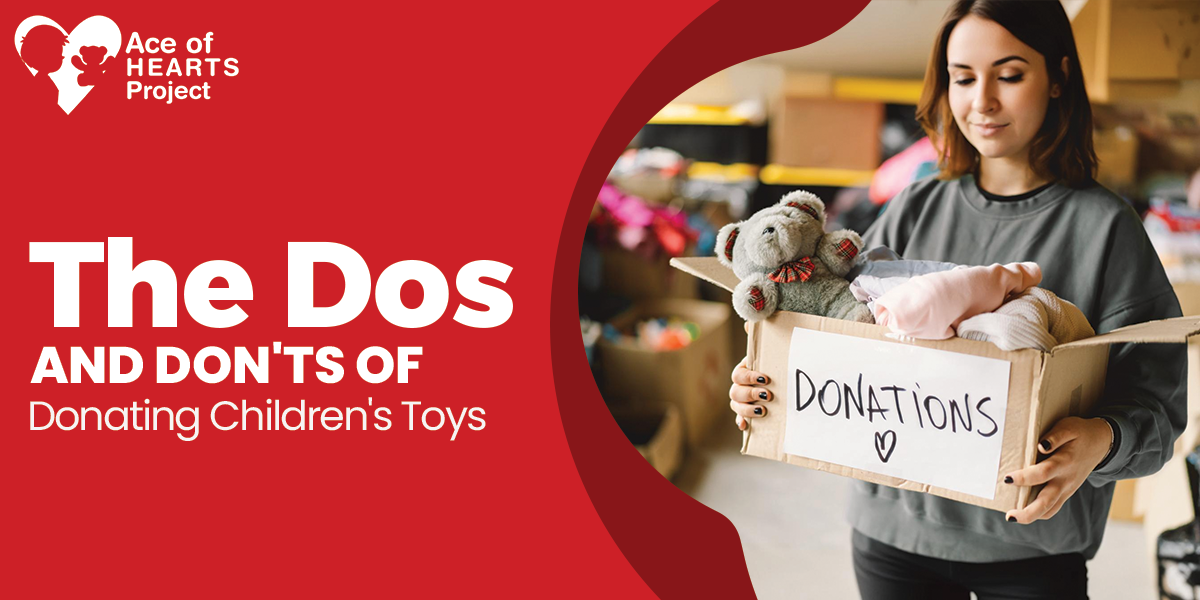The Dos and Don'ts of Donating Children's Toys
In an atmosphere where inflation is sky-high and economic insecurity is touching almost every second life almost every day, many families can’t even provide their children with the necessities. With the holiday season approaching or back-to-school season kicking into gear, the call for toy donations grows louder. Whether through toy drives, local community events, or social initiatives, donating children’s toys has become a great way of putting a smile on underprivileged children while easing the burden on their parents.
Although donating is generally done with good intentions, careful donations can have a greater impact. So, if you want to gift the joy of play to the needy, it is essential to understand its dos and don’ts of donating. From the best toys for donation to the right places for donation, knowing such things can make your every donation meaningful.
So, to help you with this, we are here with this blog, which consists of the information you need to know. Have a look!
Why Donating Children's Toys Matters More Than Ever
The pandemic may be behind us, but its aftershocks continue to affect millions. From layoffs to rising living costs, more families are turning to charities to donate toys and receive assistance. In fact, organizations such as Toys for Tots, The Salvation Army, and local shelters are reporting increased demand for toys and children's essentials in 2024.
But simply clearing out your kids’ toy box isn’t enough. Toy donations should be approached with care and consideration—after all, they’re going into the hands of little ones who deserve dignity and joy.
Dos of Donating Children's Toys
Things that should be done include:-
1. Donate New or Gently Used Toys
One of the biggest rules of thumb is to ensure the toys you donate are either new or in excellent condition. Best toys for donation are those that are clean, safe, and functional. Check for:
Missing pieces
No wear and tear
No sharp edges or broken parts
If you wouldn’t give it to your own child or gift it to a friend, it’s probably not suitable for donation.
2. Donate Unwrapped Toys
Many toy drives and charities prefer that you donate unwrapped toys. This allows the organization to sort and categorize them based on age and interest. It also makes it easier for parents or staff to choose appropriate gifts for the children they’re helping.
While wrapping may seem like a sweet gesture, it’s better to let the receiving charity take care of presentation if needed.
3. Choose Age-Appropriate Items
It’s crucial to match toys to specific age groups. For instance, small parts can pose choking hazards to toddlers, while simple picture books may not engage preteens. If you’re unsure, many organizations offer age guidelines to help donors make the right choices.
The best toys for donation often include:
Soft plush toys (for infants and toddlers)
Educational toys (for all age groups)
Board games (for older kids and families)
Art supplies, craft kits, and puzzles
4. Support Reputable Charities to Donate Toys
Research and partner with reliable, well-established organizations. Look for those that are transparent about their distribution process and have clear donation guidelines. Further, trusted charities to donate toys include:
Toys for Tots
The Salvation Army
Goodwill
Ronald McDonald House Charities
Local women's shelters and foster care programs
Some schools, hospitals, and churches also run seasonal donation drives—check your community bulletin boards or local Facebook groups.
5. Consider Cultural and Emotional Sensitivity
Avoid toys that depict violence, controversial characters, or reinforce stereotypes. Not every toy is appropriate for every child or community. So, opt for items that encourage creativity, kindness, learning, and inclusivity.
Don’ts of Donating Children's Toys
Things to avoid while donating are:-
1. Don’t Donate Broken, Dirty, or Damaged Toys
No matter how sentimental an item may be, broken or worn-out toys should not be passed along. Dirty toys can spread germs, while damaged ones can be dangerous. Take the time to clean and inspect every item before donating.
2. Don’t Forget the Batteries
If the toy is battery-operated, make sure the batteries are working or include fresh ones in the package. There's nothing more disappointing for a child than receiving a toy that doesn’t function properly. It's just a small act that has a significant impact.
3. Don’t Overlook Safety Standards
Ensure that the toys meet current safety standards. Avoid toys that have been recalled, contain toxic materials, or include magnets and button batteries that pose risks to young children. Also, check the U.S. Consumer Product Safety Commission (CPSC) website if you’re unsure.
4. Don’t Assume All Organizations Accept All Toys
Some charities have restrictions on what they can accept due to safety, space, or storage issues. Always review the donation guidelines of your chosen organization. Some may not accept stuffed animals, while others only accept new items.
5. Don’t Wait Until the Last Minute
Charities often need time to sort and distribute toys, especially during the holidays. Start your donation early to ensure it reaches the right hands in time. Planning ahead also gives you time to shop for the best toys for donation or organize a toy drive in your community.
Tips for Organizing a Toy Donation Drive
Want to do more than just donate? Think about launching a toy drive in your neighbourhood, school, or place of employment.
Here’s how to do it right:
Partner with a local charity
Set clear collection deadlines
Promote the drive-through flyers and social media
Communicate donation guidelines
Include a range of age groups in your request
Thank all participants and share the impact post-event
Organizing a group initiative can multiply the joy tenfold and create a lasting tradition of giving.
How to Find the Best Charities to Donate Toys
Not sure where to start? Here are a few ways to find trusted organizations near you:
Use platforms like Charity Navigator to check the reputation and effectiveness of nonprofits.
Search "toy donation drives near me" to discover seasonal campaigns in your area.
Contact local hospitals, orphanages, or shelters directly—they often need items year-round.
Visit big-box stores or malls during holidays—many partner with toy drives and offer donation bins.
Also, consider reaching out to schools or child advocacy programs—they often have insider knowledge on families or children in need of support.
Final Thoughts: A Toy is More Than Just a Toy
When you choose to give a toy, you’re doing more than donating an object—you’re giving happiness, hope, and a reason for a child to smile. But the real magic lies in donating children’s toys responsibly, respectfully, and with empathy.
Be thoughtful in what you give, how you give, and who you give it to. By following these simple dos and don’ts, you ensure that your donation truly makes a difference.
So the next time you clean out your closet or feel like spreading some joy, think about the thousands of children waiting for just one special gift to light up their world. Let your kindness be the reason a child believes in the magic of giving.
Ace of Hearts Project is one of the best Charities to donate toys. Contact us to know more.

